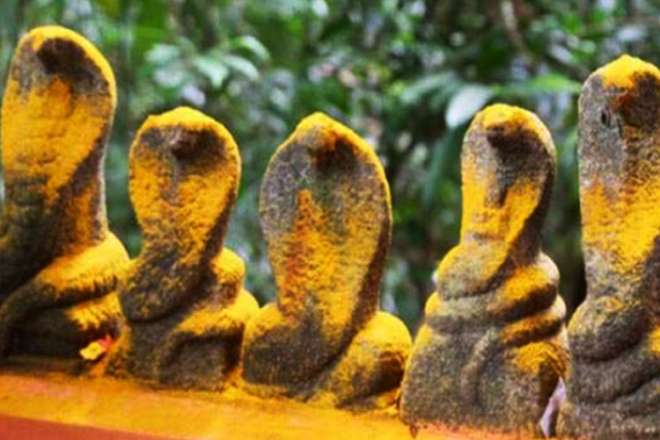HAPPY NAG PANCHAMI

Naga Panchami is a sacred Indian festival dedicated to the snake god. The festival gets its name from the fact that it is celebrated on the fifth day (Panchami) of the moonlit-fortnight of the Hindu month of Shravan (July /August). According to the Gregorian Calendar, the festival is observed sometimes in August.
2 Snakes dancing (Mating) on a pond while onlookers looking on
The exact origins of the Nagapanchami festival are uncertain. It is not known when the worship of snakes and the snake-god precisely began. The mere sight of the slithering reptile gives many of us a creepy feeling and hence, the worship of snakes in India appears strange to many people, especially those not familiar with Hindu customs. But then, snakes have been associated with many Hindu Gods. Sheshnaga (Snake with Six hoods) is the vehicle of Vishnu. The world according to Hindu mythology and cosmogony, rests on the head of Sheshnaga, and when he shakes his head we have earthquakes.
I strongly protest on these kinds of the act with snakes. It should be strictly prohibited
The custom of snake worship is believed to have come from the "Naga" clan, a highly developed tribe that lived in ancient India. The Indus Valley civilization of 3000 B.C. gives ample proof of the popularity of snake-worship amongst the Nagas, whose culture was fairly widespread in India even before the Aryans came. Later, the Indo-Aryans began to worship many of the snake deities of the Nagas and some of them even found mention in the Hindu Puranas.
A Jain Saint in the company of 2 Cobra snakes during the day of Rishi Panchami day.
Many scholars have detected traces of the existence of snake-worship contained in the 8th Ashtaka of the Rig Veda, wherein the earth is addressed as the Sarpa-Rajni or "the queen of the serpents or the queen of all that moves". The Yajur-Veda provides a more definite account of serpent worship; the Samhita of this Veda contains prayers to the Sarpas(snakes) who are addressed as denizens of the heavens, the skies, the rays of the sun, the waters, the vegetables, and the like. In the Brahmanas of the Samhita part of the Yajur-Veda, invocations are addressed to serpents and sweet sacrifices are offered for their acceptance. Manu, the ancient law-giver of the Hindus also makes mention of the Nagas and the Sarpas. Carved or painted figures of snakes can be found on the walls of many Hindu temples that exist from the medieval era. Images of snake worship rituals can also be spotted in the world-famous Ajanta caves. A detailed description of the cobra snakes can also be discerned in Arthasastra, the classic ancient Hindu political text by the great Hindu philosopher Chanakya (c.300 bc).

Temple snakes in South India are worshipped too.
In medieval India figures of snakes were carved or painted on the walls of many Hindu temples. In the carves at Ajanta images of the rituals of snake worship are found. Kautilya, in his "Arthashastra", has given.

The mention of the Nagas and the Sarpas is also found in the Mahabharata. In the sacred Hindu text Bhagavad-Gita, one witness how Lord Krishna tells Arjuna that Vasuki and Ananta represent him amongst the Sarpas and the Nagas respectively.
The Hindu Puranas(Sanskrit encyclopedic texts) also mention the Nagas and the Sarpas. In the Bhagavata Purana, Vasuki and eleven other Nagas are mentioned as forming the string of the sun's chariot one serpent being held to be sacred to each month. The Markandeya Purana embodies the well-known story of the marriage of Madalasa, a Naga princess of superb beauty, with King Kulvalasva.

In the apologue of the gold-giving serpent, the fifth fable of the Panchatantra(famous Indian collection of fables and other morally instructive tales), authentic evidence is found of the prevalence of serpent worship in the post-Vedic ages of Ancient India. As it has been established that the Panchatantra was composed sometime between the first and sixth centuries, it is believed that the tradition of snake-worship existed in India prior to the sixth century A.D. The celebrated French traveler Jean Baptiste Tavernier, in the course of his visit to India in the seventeenth century, saw the serpent worshipped in the form of an idol. Though Tavernier has neither mentioned the name of the festival nor given any further details the description corresponds with the Nagapanchami festival as it is observed throughout India at the present day.
Snake giving birth to numerous babies in a single go.
To understand the history of the festival, the time of its observance should also be kept in mind. Naga Panchami is observed in the month of Shravana (July/August), the advent of the rainy season in many parts of India. It is the time when snakes leave their holes in the flooded fields and jungles and enter the habitations of men - thereby throwing them into great consternation. It is during this period that the greatest number of deaths from snake bites occur in places like Lower Bengal. The people of the countryside labor under the impression that the only way of obtaining immunity from snakebite is by propitiating the snake-goddess Manasa. It is also the beginning of the harvest season when crops attain their full growth and the harvest is ready to be reaped. In countries like India the reaping of the harvest is (still largely) an operation manual and farmers have to work in the fields all by themselves, thus exposing themselves to the bites of poisonous snakes lurking unseen among the dense crop. This fear seems to be the main cause of Nagapanchami celebrations. Propitiating the snake god provides some psychological succor to the poor rural folk whose main occupation remains agriculture.
Apart from this, the festival also owes its origin to myriad legends and myths many of which can be traced back to the ancient Hindu Puranas. One of the Purana related to the day is given below.
In the Mahabharata epic, Janamejaya, the son of King Parikshita of the Kuru dynasty was performing a snake sacrifice known as Sarpa Satra, to avenge the death of his father from a snake bite by the snake king called Takasaka. A sacrificial fireplace had been specially erected and the fire sacrifice to kill all snakes in the world was started by a galaxy of learned Brahmin sages.

The sacrifice performed in the presence of Janamejaya was so powerful that it was causing all snakes to fall into the Yagna Kunda (sacrificial fire pit). When the priests found that only Takshaka who had bitten and killed Parisksihita had escaped to the nether world of Indra seeking his protection, the sages increased the tempo of reciting the mantras (spells) to drag Takshaka and also Indra to the sacrificial fire. Takshaka had coiled himself around Indra’s cot but the force of the sacrificial yagna was so powerful that even Indra along with Takshaka was dragged towards the fire.
This scared the gods who then appealed to Manasadevi to intervene and resolve the crisis. She then requested her son Astika to go to the site of the yagna and appeal to Janamejaya to stop the Sarpa Satra yagna. Astika impressed Janamejaya with his knowledge of all the Sastras(scriptures) who granted him to seek a boon. It was then that Astika requested Janamejaya to stop the Sarpa Satra.
Since the king was never known to refuse a boon given to a Brahmin, he relented, in spite of protects by the rishis performing the yagna. The yagna was then stopped and thus the life of Indra and Takshaka and his other serpent race were spared. This day, according to the Hindu Calendar, happened to be Nadivardhini Panchami (fifth day of the bright fortnight of the lunar month of Shravana during the monsoon season) and since then the day is a festival day of the Nagas as their life was spared on this day. Indra also went to Manasadevi and worshipped her.
According to Garuda Purana offering prayers to snakes on this day is auspicious and will usher good tidings in one’s life. This is to be followed by feeding Brahmins






.jpg)




Comments